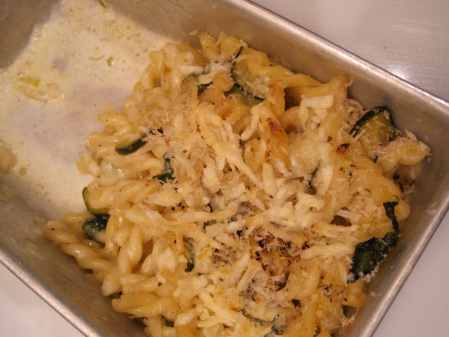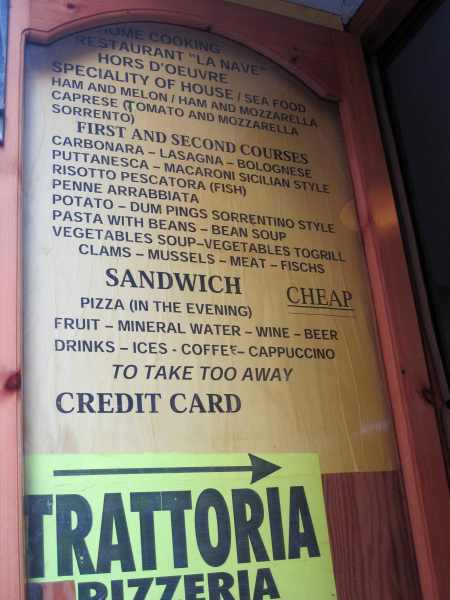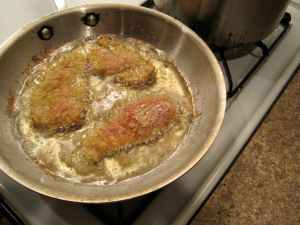My mom has been making a special pasta recipe for years that I’m told originates in some form from The Umberto Menghi Cookbook. “Leek pasta” was a favorite growing up – I couldn’t even escape its delicious embrace during a short-lived no pasta phase. It’s a simple sauce that calls for merely 6 ingredients: a bunch of leeks (2 – 4), 2 cloves of garlic, butter, white wine, chicken stock, heavy cream and Parmesan cheese.
I once tried to made the same sauce with onion in place of leek and it was delicious. I’ve left out the chicken stock by accident and it still tasted pretty good – but needed a lot of salt. (Oooh on that note, rarely do I mention salt and pepper in a list of ingredients because I just assume that you, the reader, season responsibly.) You can even get away with not adding the cheese, but, in my opinion, life just tastes better with parmesan.
Note that the amount of chicken stock and white wine you add doesn’t have to be exact. If I have lots of time and lots of leeks, I’ll add more of both. If I don’t have as much time I’ll add a little less of each to save time as it all cooks off. Both ways work, though I do prefer the leisurely practice of sipping white wine as I wait for the liquid to cook off… Also, you can use any noodle you like, though my first choice is a spaghettini or angel hair.
So, if you want to wow your friends and loved ones, here’s the recipe:
Leek Pasta
- Pour yourself a big glass of white wine.
- Chop the white and light green parts of the leeks into 2-3 inch pieces and then cut those into long thin strips (julienne). Wash them thoroughly – leeks are dirty!
- In a very large frying pan, melt one to two tablespoons of butter on medium heat and add the leeks (get your pasta water set up around now, too).
- Cook, stirring, until the leeks are translucent.
- Pour in 1/3 to 3/4 of a cup of the white wine you are drinking (a big splash).
- Chop garlic and add to simmering liquid in pan.
- When there is no liquid left, add one to two cups of chicken stock, bring back to a simmer.
- Once the liquid has nearly all cooked away, turn heat to low. Depending on what kind of noodle you are using, it’s time to cook the pasta (it might have needed to go in sooner).
- Pour a half cup of the cream into the sauce.
- Finally, add the cooked pasta to the pan and toss. You can add the cheese now or simply serve it on top of your plated pasta.
This pasta tastes really good the next day, so make at least 4 noodle servings and take the extra for lunch!
Lately we have been trying to get more green vegetables into our systems, and since this is the only basic sauce recipe that I know really well, I decided to make it with less leek (I only had two little guys leftover from the salmon with lentils night) and added the following: chopped zucchini, (1 cup), a chopped onion, chopped asparagus, (1 to 2 cups) and baby spinach (as much as you want – it will really shrink down).
For this one we did not have any white wine, which we learned was not a problem. The flavor of the sauce survived fine without it.
The directions remain the same as above, only we added the onions along with the leeks in step 3. Since we had no white wine we went straight to the chicken broth step, adding our zucchini at this time. We covered and simmered on medium heat for 10 minutes before adding the asparagus and cooking for another 10 minutes. Before we added the cream the spinach went in. It was just a few minutes before it was wilted and the sauce was done.

We used a Gemelli noodle and made such a massive batch that the next night we decided to eat it for dinner again, only this time my husband layered it in a baking dish with gruyere and cream, sprinkled it with breadcrumbs and baked it at 350 degrees for 20 minutes. It turned into a tasty mac’n’cheese-esque pasta treat that I couldn’t wait to finish the next day for lunch.

A few nights later we still had cream, zucchini and asparagus leftover so I made essentially the same sauce. We had some fresh rosemary so that got chopped and added. I also had a leftover ball of frozen potato dough from the gnocchi night so I quickly shaped some tender little dumplings and in they went. In my hungry haste I rolled the gnocchi a little more haphazardly than usual and found they tasted just as good as the perfectly shaped ones of last week, if not better.

Following the gnocchi night I also invested in a gnocchi board so out that came and what ensued was a lesson in why the little notches are key – the creamy sauce gets stored in them meaning more makes it to your mouth! Yum.










